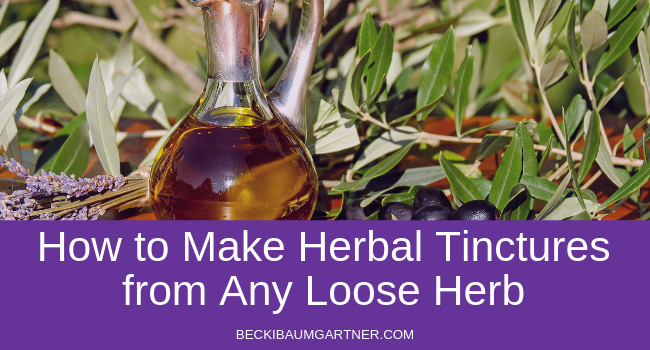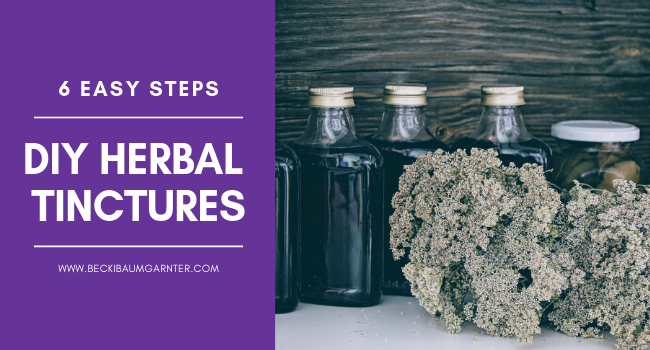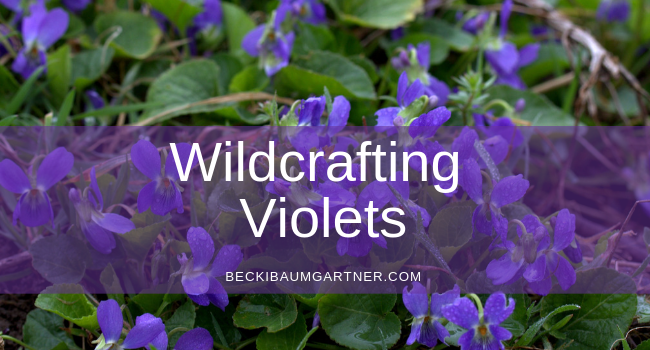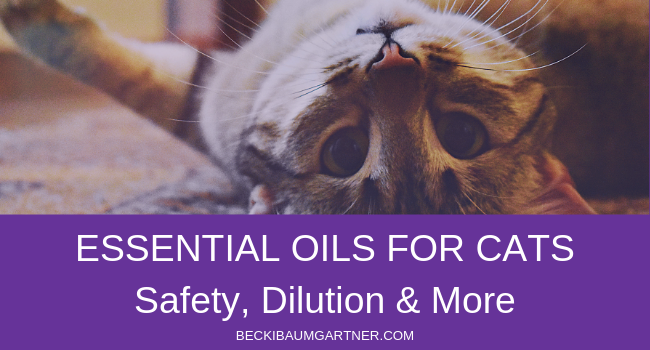You can quickly and easily make herbal tinctures from any loose herb you wildcraft.
It’s fun, and a tincture is a fantastic tool for your natural health arsenal.
What is an Herbal Tincture?
In medicine, a tincture is an alcohol-based extract of leaves or other plant material, or a solution of a non-volatile substance (like iodine).
In herbology, tinctures are potent, alcohol-based, liquid extracts made using fresh plant material in a liquid base such as vodka, brandy, vegetable glycerin, or even apple cider vinegar (all of which are safe for human consumption).
What is the Difference Between a Tincture and an Extract?
The terms are often used interchangeably by herbalists.
The pharmacological definition of a tincture is a liquid herb made using most often alcohol as the solvent, but occasionally glycerin, vinegar, and water. (If a solvent other than alcohol is used, the tinctures will not store indefinitely like those made with alcohol.)
The pharmacological definition of an extract is a concentrated substance obtained by dissolving a drug in some solvent, such as ether or alcohol, and then evaporating the preparation. In this instance, extracts are much more concentrated than tinctures.
But again, please note that many herbalists use these terms interchangeably.
Sometimes herbalists refer to a tincture as a liquid herbal made using alcohol as the solvent and refer to extracts as a liquid herbal using oil as the solvent.
It is always best to clarify this when purchasing tinctures and extracts, if the herb’s concentration concerns you.
Why Make Tinctures and Extracts?
- Extracts and Tinctures are more powerful and last longer than dried herbs.
- It is much cheaper than buying ready-made herbal products.
- You can make approximately one quart of your own extract or tincture for the price of a few ounces of tincture at retail stores.
- You can control the quality of your product by starting with herbs you collect yourself or purchasing through a reputable source. You are also ensured of the purity of the final product.
- You can custom-make unique combination formulas.
- There is something to be said about getting involved in your own health. Some herbalists say that you benefit by absorbing some of the herbs through the skin and from the aroma.
How to Make Herbal Tinctures
You will need:
- Dried or fresh herbs. (Fresh herbs are the best – one of the advantages of tincturing yourself is that you can preserve the fresh attributes of the plant. If you are using fresh herbs, pick through them removing any damaged or dirty parts, but don’t wash them.)
- 80 -100 proof vodka or rum (NEVER use rubbing, isopropyl or wood alcohol!!!) I like using 100 proof vodka. “100 proof” means it is exactly half water and half alcohol. This makes figuring dosages easy as most herbal dosages are based on the assumption that a tincture was made at 50% – 1/2 water, 1/2 alcohol. Also, tinctures made using alcohol as the solvent last indefinitely. If you are concerned about ingesting the alcohol, Rosemary Gladstar recommends placing the bottle of tincture in boiling water for 1-2 minutes which will remove about 1/2 the alcohol.)
- Wide-mouthed glass jars with lids (mason jar or equivalent).
- Unbleached cheesecloth or muslin.
- Labels and markers.
Making the Tincture: Step by Step Instructions
- Chop herbs finely.
- Pour the amount of herb you desire into the glass jar and slowly pour in the alcohol or another menstruum until the herbs are entirely covered. Then add an inch or two of additional liquid.
- Seal the jar tightly so that the liquid cannot leak or evaporate. Put the jar in a dark area or inside a paper bag and let the herbs liquid soak (macerate) for 4-6 weeks. (The longer the better).
- Shake the jar every day during the maceration period of 4-6 weeks. This keeps the herbs from packing down on the bottom of the jar and helps to extract their herbal properties. Some believe it brings some of the old “medicine making” magic back into the process — you can sing to your tincture jars, play special music, perform Reiki or other energy procedures…whatever your imagination or intuition inspires you to do!
- When ready to bottle, strain the herbs from the menstruum through a large strainer lined with cheesecloth or muslin. Save the liquid, which is now a potent tincture, and pour into another jar or glass bowl. Squeeze the saturated herbs, extracting the remaining liquid until no more drips appear, pouring this in with the previously strained tincture. Compost the herbs. Rebottle into dark colored bottles or jars and label appropriately.
- Store in a cool, dark place out of reach of children. The tinctures will keep almost indefinitely.
Additional Tips on Tinctures and Extracts
- If you are using dried herbs, plan to use 1 part herb to 3 parts menstruum. If you are using fresh herbs, plan to use 1 part herb to 1 part menstruum. (More menstruum is needed with dried herbs, as they will rehydrate while macerating.)
- If using fresh herbs, running the herbs through a blender with the menstruum can more finely chop the herbs and help to extract the properties more thoroughly and quickly.
- You should plan to start your tinctures on the day of the new moon and let them sit at least 2 weeks until the full moon – this adds a natural drawing power.
- 200 grams dried or 300 grams of fresh herbs (chopped) to one liter of liquid is needed. Some herbalists use a measurement of 1 part herb to 3 parts liquid. For exact tincture ratios, please consult a herbal textbook.
- Rum helps hide the taste of bitter herbs.
- Distilled water, vinegar or glycerol can be used to make nonalcoholic tinctures.
- The standard dosage is 1 teaspoon, 1-3 times daily, diluted in tea, juice or water.
- A wine press or juicer may be used to extract liquid from the herbs.
- Several herbs can be combined into a tincture formula.
Experiment and have fun!
Sources:
- Gladstar, R. (2008). Rosemary Gladstar’s Herbal Recipes for Vibrant Health. North Adams, MA: Storey Publishing.
- Herbal Tincture Recipe for Aromatherapy/Skin Care. AromaWeb.com. Extracted July 22, 2010, from http://www.aromaweb.com/recipes/herbaltincturesrecipe.asp
- Making Herbal Tinctures. Herbal Remedies Info. Extracted July 22, 2010, from http://www.herbalremediesinfo.com/tinctures.html
- Satchell, M. “How to Make Your Own Herbal Tincture from Any Loose Herb” extracted from http://www.kcweb.com/herb/tincture.htm






